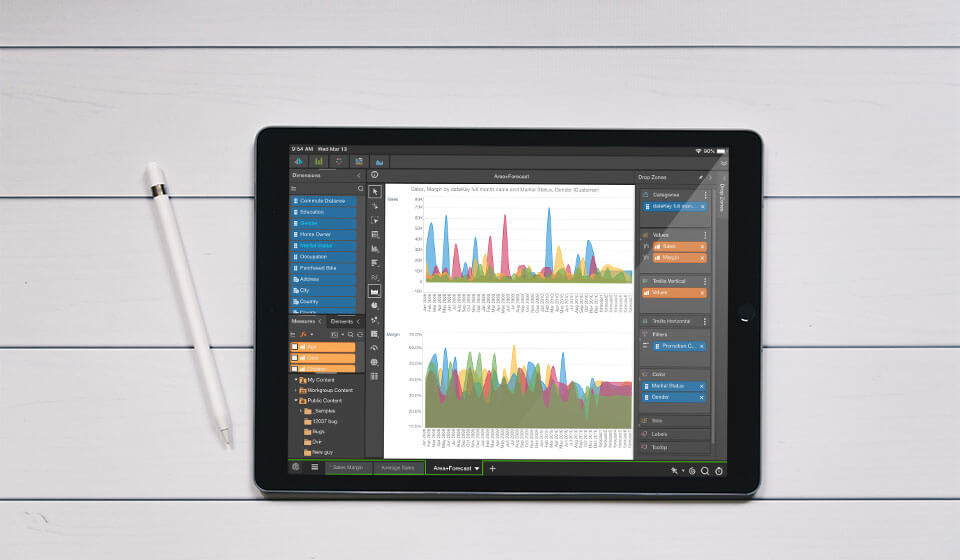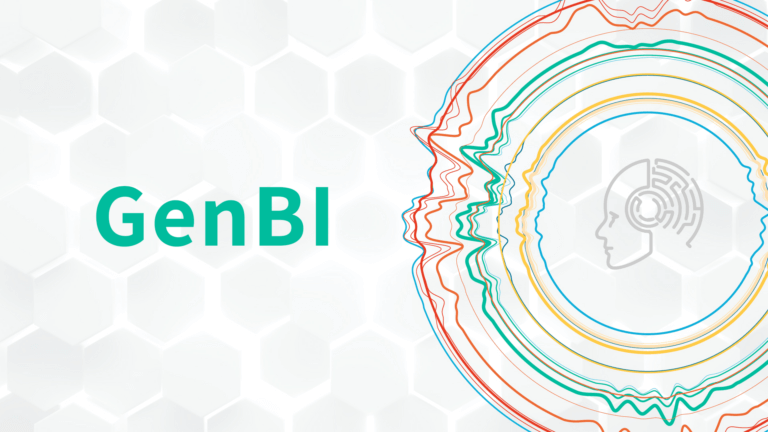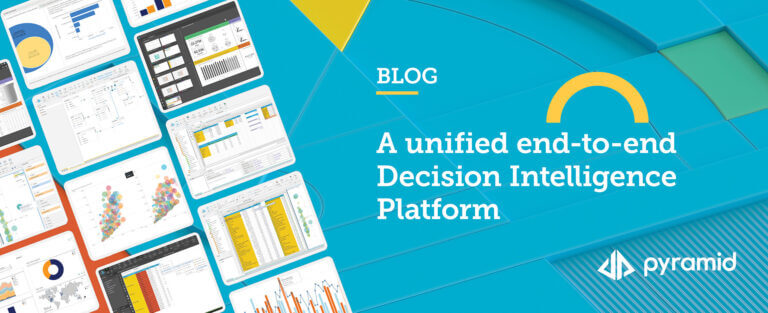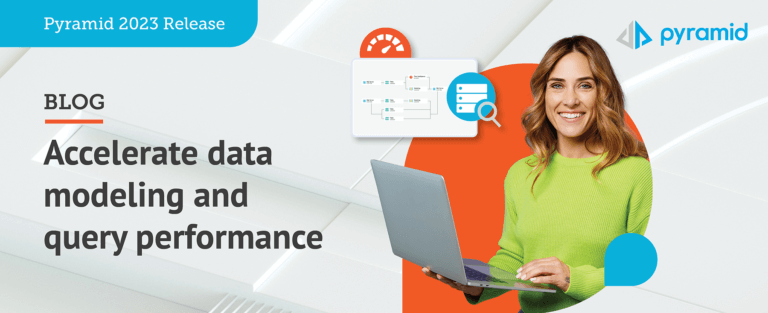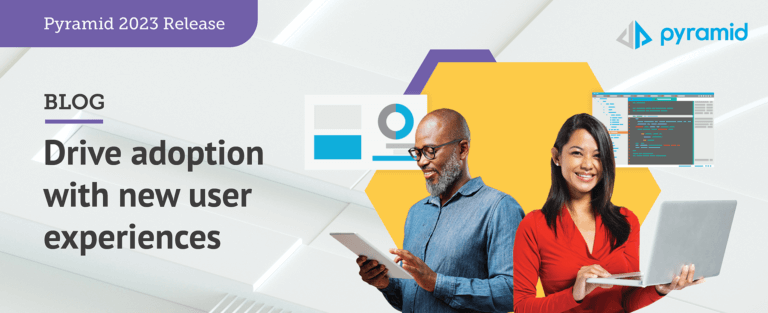“Data-driven organizations need to allow users to freely innovate with data while still maintaining governance, security, and control. The challenge then becomes: how can they facilitate these seemingly paradoxical objectives?”
Most organizations today realize they need to become data-driven to remain competitive. In finding the formula for building a data-driven culture, organizations invariably discover they need to let their end-users access and use data in smart, efficient ways. At the same time, they also realize it needs to be conducted in a governed and controlled fashion. This then is the key conceptual dilemma that data-driven organizations face today: balancing data innovation and control.
When you narrow in on the most well-known offerings—like those found in the Gartner 2019 Magic Quadrant for Analytics and Business Intelligence Platform—it becomes clear there are actually only a handful of solutions capable of delivering enterprise-grade capabilities that accommodates both needs. And Pyramid Analytics quickly rises to the top of that short list.
The older “legacy” solutions continue to put too much emphasis on centralized governance and IT-centric analytic options, producing “IT dictatorships.” In these environments, end users are blocked from easily accessing data and getting the most out of their analytics solutions.
The more modern solutions are simplistic visualization tools, most often desktop-based. Untethered, these tools offer data access with little central oversight and control, resulting in a “silo epidemic.” Each individual group or department has their own analytics tool, data, and insights. In these environments, data congruency and analytic consistency suffers.
This is where Pyramid’s approach to analytics spotlights a striking difference.
Pyramid was built to occupy the balance between these two extremes—accentuating the benefits of each approach, without compromise. End users benefit from the innovation that results when anyone is free to collaborate and interact with data. IT maintains the proper governance that discourages the formation of data silos, keeping data and analytic assets secure.
How has Pyramid Analytics managed to create its Analytics OS™ platform that facilitates an analytic workflow that simultaneously empowers end users and maintains organizational control of their data?
The answer lies in three foundational “pillars” that have driven the design principles of the platform:
- Democratized analytics
- Collective knowledge
- Manageability
Focusing on these pillars has positioned Pyramid Analytics as the preeminent modern enterprise analytics platform.
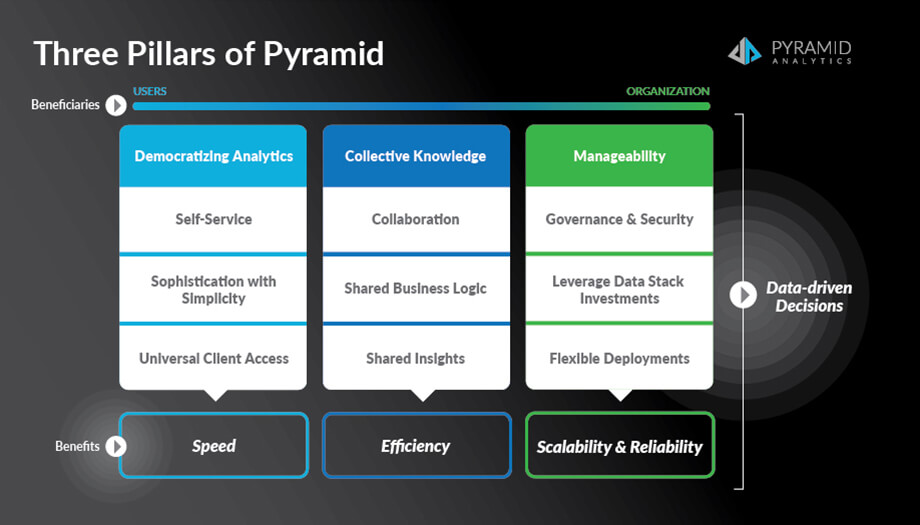
Democratizing Analytics
Data is useless if you cannot put it into the right hands. However, not everyone has the skill to make sense of data using advanced data analytics tools. Our experience has shown that the best analytics deployments “democratize analytics.” That is, they give users appropriate access to data and tailor functionality to optimize the experience on an individual basis.
To do this, Pyramid combines simple to use yet sophisticated self-service functionalities with universal client access. It’s a server-based application that features a web-based front-end, which eliminates the need for organization-wide software installs. More significantly, it means that no data or content resides locally, so while the tools are personalized and desktop-like, there is no organizational leakage. And by managing data centrally and exposing it via a web-browser, the right people can have access to the right data at the right time.
The primary beneficiary of democratized analytics is the end-user. When the barriers to data access are removed and users are given tools tailored to their level of expertise, they are more likely to have a positive analytics experience. And by democratizing data, organizations reap the benefits of speed, agility, and creativity typically associated with desktop visualization tools—without the drawbacks of data silos.
Collective Knowledge
Content produced by individuals in an enterprise has almost no value if it cannot be easily disseminated throughout the organization. That brings us to the second pillar critical to Pyramid’s success: “collective knowledge.” Organizations that are able to cultivate an analytics environment where individual efforts can be stored, shared, and re-used become infinitely more efficient. Better collaboration and improved data accuracy are two key outcomes of collective knowledge.
As a server-based platform, all models, data, content and analysis are centrally stored, and can be curated and shared throughout the organization. This ensures that when end-users interact with content, they can be confident of its origin, and the validity and timeliness of the underlying data.
In addition, collaborative workflows let teams solve data problems together. Shared business logic permits re-use of data formulations and insights. It aligns end users with an organization’s goals and deepens their understanding of its processes and direction. This results in a more focused, efficient data driven decision-making process.
Manageability
The benefits of democratized analytics and collective knowledge can never be fully realized if they’re built on a platform that is not centrally driven. This brings us to the final pillar that sets Pyramid apart: a focus on enterprise “manageability.”
Security and governance are integral components. They ensure that vital data, content, and IP are easily organized and secured. While end-users should have broad access to data and functionality that matches their functional needs wherever possible, boundaries are always required to protect sensitive, valuable information. Pyramid is designed to incorporate governance at every level so organizations can exert control of the data where necessary, without resorting to a data dictatorship.
Another key aspect of manageability relates to data infrastructure and deployment flexibility. With Pyramid, an organization can leverage existing data stack investments, and can choose how and where analytics are applied, without the inefficiency or cost of transferring terabytes of data from existing data warehouses to proprietary data layers. This allows organizations to leverage their previous investments and enterprise infrastructure—accelerating the time to results.
Last, organizations can also deploy the platform—on premises, in the cloud, or both—according to their business needs and data priorities.
Implementations that are flexible, governed, and secure see remarkable benefits in terms of scalability and reliability. That’s why Pyramid comes with powerful manageability tools. It’s the glue that holds the analytics platform together.
How they Work Together
The fusion of these goals—which go well beyond data visualizations—is a BI solution that epitomizes the “modern enterprise analytics platform.” By democratizing analytics, end users can rapidly access data, perform analytics, and generate insight without having to engage a hierarchy that may be slow to move. Dispersing these insights through a system that supports collective knowledge generates efficiencies and encourages collaboration. And all of this is effectively managed on a platform that is scalable, reliable, and secure.
And that’s why customers choose Pyramid to deliver a data-driven decision-making platform. Schedule a demo today and see how we can help your business as well!




